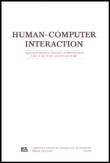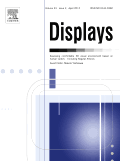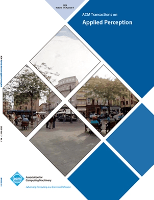
HUMAN-COMPUTER INTERACTION
Scope & Guideline
Transforming User Experience Through Research
Introduction
Aims and Scopes
- User Experience and Interaction Design:
Research that delves into the design and evaluation of interfaces and interactions to improve user engagement, satisfaction, and overall experience. - Assistive Technologies and Accessibility:
Exploration of technologies and systems aimed at supporting individuals with diverse cognitive abilities and disabilities, ensuring inclusivity in technology usage. - Human-Centric AI and Intelligent Systems:
Investigation into the design and implications of AI systems that interact with users, focusing on transparency, ethics, and user acceptance. - Socio-Technical Systems and Contextual Design:
Examination of the broader social and environmental contexts in which technology operates, including user behaviors, cultural impacts, and ethical considerations. - Emerging Technologies and Their Impact:
Analysis of new technological trends such as virtual reality, augmented reality, and brain-computer interfaces, and their implications for human interaction.
Trending and Emerging
- More-than-Human Design:
Research focusing on the integration of non-human elements into design practices, reflecting a shift towards understanding technology in a broader ecological and social context. - AI Ethics and User Interaction:
Increased interest in the ethical implications of AI technologies, particularly how they affect user autonomy, privacy, and trust in automated systems. - Cognitive and Emotional Accessibility:
Emerging emphasis on designing for emotional and cognitive needs, particularly for individuals with disabilities, to enhance user experience and engagement. - Virtual and Augmented Reality Applications:
A significant rise in research around the use of VR and AR technologies, particularly in training, education, and therapeutic contexts, showcasing their potential for immersive user experiences. - Data Privacy and Personal Information Management:
Growing concern and research around how users manage their personal data, privacy challenges, and the implications of data sharing in digital environments.
Declining or Waning
- Traditional Usability Studies:
Research that primarily focuses on basic usability testing and heuristics is becoming less prominent as the field moves towards more complex user interaction paradigms that incorporate emotional and contextual factors. - Static Interaction Models:
The emphasis on fixed models of user interaction is declining, with more researchers exploring dynamic, adaptable systems that respond to user needs in real-time. - Generalized User Profiles:
Studies that rely on broad, generalized user profiles for design are waning as the field shifts towards personalized and context-aware design methodologies. - Desktop-Centric Applications:
Research focusing exclusively on desktop applications is decreasing, as there is a growing trend towards mobile, wearable, and immersive technologies that cater to diverse environments. - Single-Disciplinary Approaches:
The reliance on single-disciplinary perspectives is fading as the journal increasingly encourages interdisciplinary approaches that integrate insights from sociology, psychology, and design.
Similar Journals

INTERNATIONAL JOURNAL OF HUMAN-COMPUTER STUDIES
Bridging the Gap Between Users and MachinesINTERNATIONAL JOURNAL OF HUMAN-COMPUTER STUDIES, published by Academic Press Ltd - Elsevier Science Ltd, stands at the forefront of research dedicated to the dynamic interplay between humans and technology. With a remarkable impact factor reflective of its rigorous academic standards and its prestigious ranking in the Q1 category across vital disciplines such as Education, Engineering, Human Factors and Ergonomics, and Human-Computer Interaction, this journal serves as an essential resource for researchers, professionals, and students alike. Spanning from 1994 to 2024, it showcases pioneering studies that contribute significantly to the understanding of cognitive processes, usability, and the evolving role of technology in society. Despite the absence of Open Access options, access to this journal is facilitated through institutional subscriptions, ensuring that critical findings and advancements are readily available to a global audience. By continuing to publish high-quality research, the INTERNATIONAL JOURNAL OF HUMAN-COMPUTER STUDIES plays a crucial role in advancing the field, fostering innovation, and guiding future research directions.

DISPLAYS
Connecting Engineering Excellence with User ExperienceDISPLAYS is a prestigious journal published by Elsevier that focuses on the dynamic intersection of Electrical and Electronic Engineering, Hardware and Architecture, and Human-Computer Interaction. Since its inception in 1979, the journal has made significant contributions to advancing the field, currently holding a notable impact factor and ranking within the Q2 category across multiple disciplines, including Electrical and Electronic Engineering, Hardware and Architecture, and Human-Computer Interaction. With its broad scope, DISPLAYS is dedicated to publishing high-quality research that inspires innovation in display technology and its applications. Researchers and professionals benefit from access to cutting-edge findings in the realm of display systems, which are integral to the evolving landscape of digital interaction. Operating without an open access option, the journal ensures rigorous peer review, maintaining the highest standards of academic integrity and research quality. Positioned in the heart of the Netherlands, DISPLAYS continues to play a critical role in shaping future advancements, making it an essential read for anyone committed to these vital fields of study.

ACM Transactions on Applied Perception
Exploring the Nexus of Perception and ComputationACM Transactions on Applied Perception is a leading journal published by the Association for Computing Machinery, focusing on the intersection of perception science and computational methods. With an ISSN of 1544-3558 and an E-ISSN of 1544-3965, this esteemed publication has been a vital resource for innovators and researchers since its establishment in 2004. It operates within the ambit of Computer Science and the realms of Experimental and Cognitive Psychology, boasting a commendable impact factor and category rankings, including Q2 in Computer Science (miscellaneous) and Q3 in both Experimental and Cognitive Psychology and Theoretical Computer Science. The journal's scope encompasses a plethora of studies aimed at understanding human perception through computational lenses, making it an essential platform for scholarly exchange. Although it does not currently offer an Open Access option, its extensive reach and rigorous peer-review process ensure high visibility and impact in the academic community. By fostering collaboration across disciplines, ACM Transactions on Applied Perception encourages advancements that bridge perceptual research with practical applications, making it invaluable for researchers, professionals, and students engaged in this dynamic field.

Human-centric Computing and Information Sciences
Exploring the Nexus of Human Interaction and ComputingHuman-centric Computing and Information Sciences, published by the Korea Information Processing Society, represents a leading platform in the field of computer science, particularly focusing on the interaction between humans and computational systems. With an impressive Q1 ranking in the 2023 category of Computer Science (miscellaneous) and a commendable Scopus rank of #14/232 (94th percentile), this journal has established itself as a cornerstone for researchers and practitioners dedicated to advancing understanding in this vital area. Understanding the significance of making technology more accessible and effective for users, the journal has been an Open Access publication since 2011, promoting wide dissemination of knowledge without barriers. The journal's scope encompasses innovative methodologies, user experience design, and the integration of human factors into computing environments, making it essential reading for anyone interested in the intersection of technology and society. With all articles freely accessible, the journal not only contributes to scholarly discourse but also encourages collaboration among researchers worldwide, fostering further advancements in human-centric computing.

Universal Access in the Information Society
Exploring the intersection of technology and universal access.Universal Access in the Information Society is a distinguished academic journal published by SPRINGER HEIDELBERG, focusing on the critical fields of computer networks, human-computer interaction, information systems, and software. Established in 2003, this periodical aims to disseminate innovative research that tackles the challenges of universal access to information and communication technologies, making it a vital resource for researchers, professionals, and students dedicated to enhancing digital inclusivity. With a commendable impact reflected in its Scopus rankings, it places in the second quartile for Computer Networks and Communications and Information Systems, as well as in the third quartile for Human-Computer Interaction, verifying its pivotal role in advancing knowledge within these domains. Although currently not open access, the journal offers comprehensive insights that are essential for anyone looking to contribute to or comprehend the evolving landscape of information societal access. The journal's commitment to bridging knowledge gaps makes it indispensable for both academic and practical applications in the Information Society.

Frontiers in Computer Science
Pioneering open-access discoveries in diverse computer science fields.Frontiers in Computer Science is a premier open-access journal published by Frontiers Media SA that has rapidly established itself as a prominent platform for scholarly research in the diverse and evolving field of computer science. With a notable impact factor reflecting its high citation rates, this journal aims to disseminate innovative findings and groundbreaking studies across multiple subdisciplines, including Computer Science Applications, Computer Vision and Pattern Recognition, and Human-Computer Interaction. Since its inception in 2019, and with a consistent trajectory from 2019 to 2024, it has garnered accolades, achieving Q2 ranking in several categories and an impressive Q1 in miscellaneous areas of computer science. Researchers, professionals, and students alike are encouraged to contribute to this dynamic journal that serves as a vital resource for advancing knowledge and fostering collaborative dialogue in the global computer science community. Frontiers in Computer Science is committed to providing open access to research, promoting unrestricted sharing of ideas and fostering innovation at the intersection of technology and society.

Multimodal Technologies and Interaction
Transforming Interaction Design for Tomorrow's Technologies.Multimodal Technologies and Interaction, published by MDPI since 2017, is an esteemed open-access journal based in Switzerland, dedicated to the exploration and advancement of innovative multimodal systems that enhance user experience across various digital platforms. With its commitment to disseminating high-quality research in diverse areas such as Computer Networks and Communications, Human-Computer Interaction, and Neuroscience, the journal has rapidly established itself within the academic community, achieving a commendable position in Scopus rankings including Q2 in both Computer Networks and Communications and Computer Science Applications. As an essential resource for researchers, professionals, and students alike, Multimodal Technologies and Interaction fosters interdisciplinary dialogue and supports the development of cutting-edge technologies, ensuring that advancements in multimodal interaction are accessible to a global audience. Scholars can benefit from its Open Access format, allowing unrestricted access to influential studies that shape the future of technology and interaction design.

INTERNATIONAL JOURNAL OF HUMAN-COMPUTER INTERACTION
Exploring the Synergy Between Humans and TechnologyINTERNATIONAL JOURNAL OF HUMAN-COMPUTER INTERACTION, published by Taylor & Francis Inc, stands at the forefront of research within the interdisciplinary fields of human-computer interaction, human factors, and ergonomics. Since its establishment, the journal has consistently contributed to advancing the understanding of the interactions between people and computers, making it a vital resource for researchers, professionals, and students alike. With an impressive impact factor reflecting its high citation rate, this journal is recognized as a Q1 publication in both Computer Science Applications and Human Factors and Ergonomics categories for 2023, showcasing its stature within the academic community. Additionally, it boasts a commendable ranking within the top percentiles in key areas on Scopus, ensuring that the research published here reaches broad scholarly audiences. Available in traditional subscription format, the journal covers seminal studies from 1989 to 2024, reflecting ongoing innovation in technology and its applications in everyday life, and thus serves as an essential platform for pioneering research that shapes the future of user experience.

International Journal of Digital Multimedia Broadcasting
Transforming the Landscape of Communication StudiesThe International Journal of Digital Multimedia Broadcasting is a leading scholarly platform dedicated to the interdisciplinary exploration of digital multimedia broadcasting, published by HINDAWI LTD. With an ISSN of 1687-7578 and an E-ISSN of 1687-7586, this Open Access journal has made significant strides since its inception in 2008, ensuring wide accessibility and dissemination of research. Based in the United States, at Adam House, 3rd Flr, 1 Fitzroy Sq, London W1T 5HF, England, the journal covers a range of topics relevant to Communication, Electrical and Electronic Engineering, and Media Technology, boasting impressive Scopus rankings that highlight its influence in these fields. As part of the Q3 category in Communication and Electrical Engineering, and Q2 in Media Technology for 2023, the journal serves a vital role in fostering the understanding of technological advancements and their applications in multimedia broadcasting. Researchers, professionals, and students are encouraged to contribute to and benefit from the journal's rich repository of knowledge, paving the way for innovative developments in this dynamic industry.

Journal on Multimodal User Interfaces
Advancing User Experience Through Multimodal InsightsJournal on Multimodal User Interfaces, published by Springer, serves as a vital platform for scholarly exchange in the rapidly evolving fields of Human-Computer Interaction and Signal Processing. Established in 2008 and continuing through 2024, this journal maintains a high profile in academia, currently ranking in the Q2 category for both fields, indicating its significant contribution to ongoing research and practical applications. With its Scopus rankings placing it at #34 in Signal Processing and #49 in Human-Computer Interaction, it is recognized for publishing high-quality, impactful research. Although it is not an Open Access journal, the Journal on Multimodal User Interfaces remains accessible through institutional subscriptions. Researchers, professionals, and students will find the journal an essential resource for advancing knowledge and fostering collaboration in multimodal interaction technologies, which are crucial for enhancing user experience and developing intelligent systems.